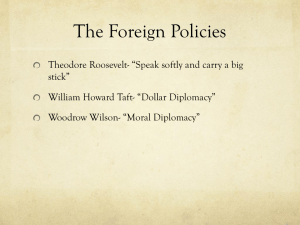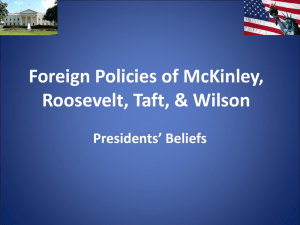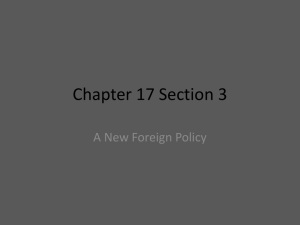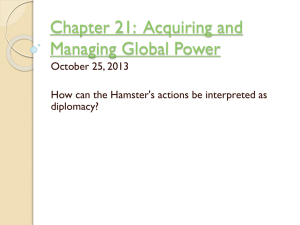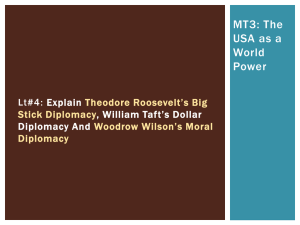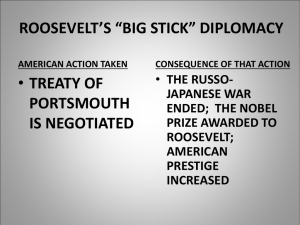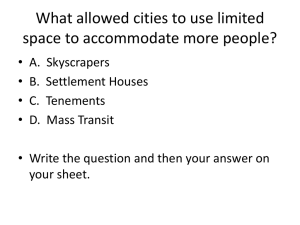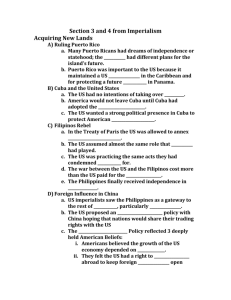chapter 18 section 4 notes a
advertisement
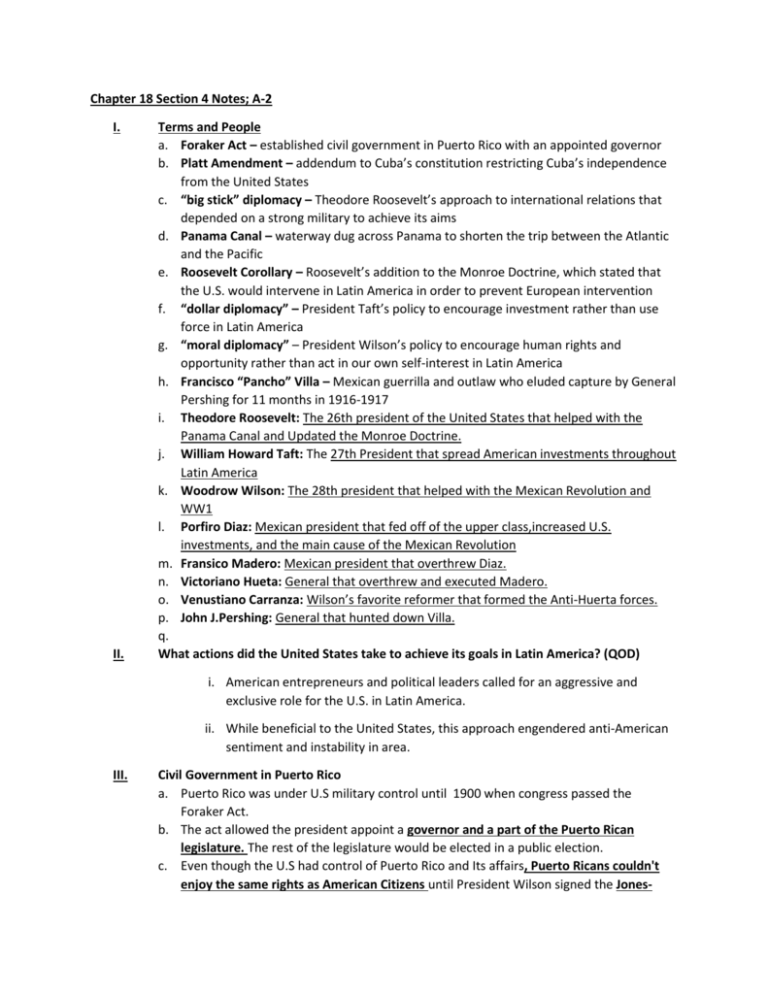
Chapter 18 Section 4 Notes; A-2 I. II. Terms and People a. Foraker Act – established civil government in Puerto Rico with an appointed governor b. Platt Amendment – addendum to Cuba’s constitution restricting Cuba’s independence from the United States c. “big stick” diplomacy – Theodore Roosevelt’s approach to international relations that depended on a strong military to achieve its aims d. Panama Canal – waterway dug across Panama to shorten the trip between the Atlantic and the Pacific e. Roosevelt Corollary – Roosevelt’s addition to the Monroe Doctrine, which stated that the U.S. would intervene in Latin America in order to prevent European intervention f. “dollar diplomacy” – President Taft’s policy to encourage investment rather than use force in Latin America g. “moral diplomacy” – President Wilson’s policy to encourage human rights and opportunity rather than act in our own self-interest in Latin America h. Francisco “Pancho” Villa – Mexican guerrilla and outlaw who eluded capture by General Pershing for 11 months in 1916-1917 i. Theodore Roosevelt: The 26th president of the United States that helped with the Panama Canal and Updated the Monroe Doctrine. j. William Howard Taft: The 27th President that spread American investments throughout Latin America k. Woodrow Wilson: The 28th president that helped with the Mexican Revolution and WW1 l. Porfiro Diaz: Mexican president that fed off of the upper class,increased U.S. investments, and the main cause of the Mexican Revolution m. Fransico Madero: Mexican president that overthrew Diaz. n. Victoriano Hueta: General that overthrew and executed Madero. o. Venustiano Carranza: Wilson’s favorite reformer that formed the Anti-Huerta forces. p. John J.Pershing: General that hunted down Villa. q. What actions did the United States take to achieve its goals in Latin America? (QOD) i. American entrepreneurs and political leaders called for an aggressive and exclusive role for the U.S. in Latin America. ii. While beneficial to the United States, this approach engendered anti-American sentiment and instability in area. III. Civil Government in Puerto Rico a. Puerto Rico was under U.S military control until 1900 when congress passed the Foraker Act. b. The act allowed the president appoint a governor and a part of the Puerto Rican legislature. The rest of the legislature would be elected in a public election. c. Even though the U.S had control of Puerto Rico and Its affairs, Puerto Ricans couldn't enjoy the same rights as American Citizens until President Wilson signed the Jones- IV. V. VI. VII. VIII. Shaforth Act. This gave Puerto Ricans more rights and control over their legislature, but they felt it was enough. U.S Establishes Cuban ProtectorateThe Platt Amendment a. Treaty of Paris gave Cuban Independence, but the U.S had stationed their military there until 1902. b. Before the U.S. left they got Cuba to add the Platt Amendment to their constitution. c. The amendment restricted Cuban rights, brought them into the affairs of the U.S and Cuba couldn’t sign treaties with other countries. d. Cuba realized that the U.S wasn’t going to leave because they were afraid of another hostile power taking Cuba, so Cuba added the Platt Amendment. Roosevelt updates the Monroe Doctrine a. Latin American countries struggle to pay off their debts to European countries in the early 1900s. b. In 1903 Great Britain and Germany blocked Venezuelan ports until they could pay of their debts. c. In 1904 Roosevelt sent a message to Congress. The message had in it Roosevelt’s Latin American policy called Roosevelt’s Corollary. d. The corollary made America a “police force” so Latin America wouldn’t commit “chronic wrong doings.” These doing where a way for European countries to justify their presence. Latin America’s hatred toward the Roosevelt Corollary a. Latin Americans disapproved of the “police force” idea that Roosevelt had because they felt that America thought L.A. couldn’t enforce itself. b. Francisco Garcia Calderon said that the Monroe Doctrine had taken an “aggressive form with Mr. Roosevelt.” c. Augusto Sandino agreed with Calderon and began to rebel against U.S. marines in Nicaragua.(1920s) Roosevelt’s “Big Stick” diplomacy: a. Roosevelt made a new diplomacy from America’s victory in the Spanish American War. b. The new diplomacy relied heavily on America’s military to accomplish the country’s goals c. “Big Stick” was inspired from an old African saying “Speak softly and carry around a big stick” d. The saying connects because Roosevelt felt that The U.S. should carry around a big stick during the Age of Imperialism and felt that it was the duty of the U.S. to civilize or uplift weaker nations. America and the Panama Canal. a. A French company thought to connect the Atlantic and Pacific Oceans. They soon failed and asked The U,S, to buy their claim for $40 million.(1903) b. America knew that the canal couldn’t be built without Colombian permission, so America tries to negotiate for the Isthmus of Panama. c. Negotiation fails due to fact that Columbia wanted more money than the U.S was willing to pay. IX. X. XI. d. Then, Roosevelt intervenes by sending U.S warships to the costs of Panama. The battleships helped the Panamanian rebels fight off the Columbian forces. e. After the Colombians were dominated by the rebels and The U.S, Panama is declared an independent nation. f. Panama allows the U.S, to dig the canal for $10 million and an annual rent of $250,000. g. 35,000 workers helped build the canal, and 5,000+ died due to accidents or disease. h. The water way soon opened in 1914 cutting off 8,000 miles from America’s trading route from west to east coast. Taft Along With His Dollar Diplomacy a. William Howard Taft was chosen by Roosevelt for the President. Taft agreed with Roosevelt’s foreign policy objectives. Taft won the election of 1908 and would keep the Open Door Policy. Taft also wanted to ensure stability in Latin America (Background on Taft). b. Taft wanted to achieve by relying on “dollar diplomacy” more than “big sick diplomacy.” c. The diplomacy wanted to increase American investments (mines, plantations, oils, wells, etc.) throughout L.A. and the Caribbean islands. d. The dollar diplomacy sometimes needed military intervention. Taft dispatched American troops to Nicaragua in 1909 and in 1912 Wilson’s Moral Diplomacy a. Woodrow Wilson wanted to concentrate on human rights, national integrity and opportunity and promised that America wouldn’t conquer anymore. (Moral Diplomacy). b. Instead of using the military for the other two diplomacy’s reasons, Wilson used them to guide L.A. to the directions he thought were proper. Ex. Wilson sent U.S. Marines to protect American investments and to protect Haiti from French and German aggression (1915). c. Wilson got Haiti to allow America to have the right to its finical and foreign affairs. d. Soldiers and Sailors also intervened in Mexico and the Dominican Republic. The Mexican Revolution a. Porfirio Diaz had been in power for decades and benefitted from the small upper class (Wealthy landowners, clerics, and military men). b. Diaz’s encouragement led to American investments to grow immensely, but this caused Americans to own large portions of Mexican industries. c. Foreign Investors, and Mexican Aristocracy grows but the lower class is having a hard time with poverty. d. In 1911 Francisco Madero led the revolution that got rid of Diaz and Madero took the Presidency e. Madero sought reforms but wasn’t very strong, so in 1913 General Victoriano Huerta seized power and executed Madero under “dollar diplomacy” f. Even though Wilson probably recognized Huerta as leader and his pledge to protect American Investments, Wilson turned Huerta down and preferred Veneustiano Carranza (Reformer who started the Anti-Huerta forces) XII. XIII. Wilson sends Troops to Mexico a. Wilson sends U.S. troops to help out Carranza get power. Wilson sent Marines to capture the port of Veracruz. This captured destroyed Huerta’s government and allowed Carranza to take the presidency. b. Huerta’s defeat made many Mexicans happy and validated “moral diplomacy” until Wilson found out that Carranza was slow at bringing reforms and another rebellion starts. c. Francisco “Pancho” Villa rises up from this rebellion and is courted by Wilson until 1916 when U.S. support ends. d. Villa enters New Mexico and attacks Columbus killing 18 Americans. This angers Wilson and he sends General John J. Pershing along with 10,000 troops. Pershing vs. Villa a. Pershing’s troops chased after Villa. The chase lasted for several months but Villa escaped. b. The troops were pulled out in 1917 because America declared war on Germany.
